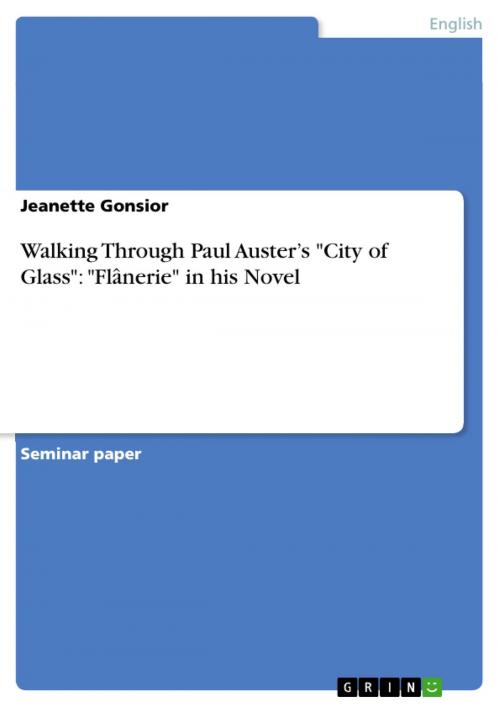Walking Through Paul Auster's 'City of Glass': 'Flânerie' in his Novel
Nonfiction, Entertainment, Drama, Anthologies| Author: | Jeanette Gonsior | ISBN: | 9783640268931 |
| Publisher: | GRIN Verlag | Publication: | February 16, 2009 |
| Imprint: | GRIN Verlag | Language: | English |
| Author: | Jeanette Gonsior |
| ISBN: | 9783640268931 |
| Publisher: | GRIN Verlag |
| Publication: | February 16, 2009 |
| Imprint: | GRIN Verlag |
| Language: | English |
Seminar paper from the year 2006 in the subject American Studies - Literature, grade: 1,0, Humboldt-University of Berlin (Department of English and American Studies), course: The Flaneur and the Visual Culture of the City, 30 entries in the bibliography, language: English, abstract: 'To stroll is a science, it is the gastronomy of the eye. To walk is to vegetate, to stroll is to live.' (Balzac, 'Physiologie du Mariage') 'City of Glass' is Paul Auster's first novel, published in 1985, after being rejected by several publishers. The first part of 'The New York Trilogy' has been translated into 17 languages so far, a fact that pleads for the novel's commercial success nowadays. An indication for the literary importance of 'City of Glass' is the continually growing number of essays, anthologies and monographs all over the world. It is undeniable that its selling success is related to the general fascination for the cosmopolitan city of New York and for detective stories, as - at first sight - Auster's novel follows the tradition of Edgar Allan Poe. However, he follows the tradition 'as creator of 'the lost ones'', as - on closer inspection - the reader has to realize that the real mystery is one of confused character identities and realities. 'City of Glass' does not meet the reader's expectations about a typical New York 'city novel': Auster created an adequate text for a modified, postmodern cityscape where all objects of the city seem like linguistic codes that need to be deciphered. The risks of the city result from the confusion of language and perception. The fear of an identity collapse comes along with the apparent collapse of the cityscape. Auster picks out the loss of stability and security in the city as central theme. He describes a world begging for order and interpretation where 'nothing is real except chance'. (...) Auster's character Quinn is a deconstructed character of postmodernism, he acts like a 'flâneur', but does not feel comfortable while walking through the city, he seems lost. New York is the 'nowhere' Quinn has built around himself. Professor Stillman also seems to stroll like a 'flâneur', but he has to fulfill an operation (in contrast to the 'classical' 'flâneur' who has no aim). Auster deconstructs the postmodern figure of the flâneur as he deconstructs the classical detective novel. Ironically, these very deconstructions help to shape the novel. Quinn can be read as flâneur adapted to a postmodern world, I argue. In the following, I will explore the relations between Auster's 'City of Glass' and concepts of 'flânerie', strolling urban observing. In order to discuss 'flânerie' in Auster's work, it is essential to take a closer look on the term first. (...)
Seminar paper from the year 2006 in the subject American Studies - Literature, grade: 1,0, Humboldt-University of Berlin (Department of English and American Studies), course: The Flaneur and the Visual Culture of the City, 30 entries in the bibliography, language: English, abstract: 'To stroll is a science, it is the gastronomy of the eye. To walk is to vegetate, to stroll is to live.' (Balzac, 'Physiologie du Mariage') 'City of Glass' is Paul Auster's first novel, published in 1985, after being rejected by several publishers. The first part of 'The New York Trilogy' has been translated into 17 languages so far, a fact that pleads for the novel's commercial success nowadays. An indication for the literary importance of 'City of Glass' is the continually growing number of essays, anthologies and monographs all over the world. It is undeniable that its selling success is related to the general fascination for the cosmopolitan city of New York and for detective stories, as - at first sight - Auster's novel follows the tradition of Edgar Allan Poe. However, he follows the tradition 'as creator of 'the lost ones'', as - on closer inspection - the reader has to realize that the real mystery is one of confused character identities and realities. 'City of Glass' does not meet the reader's expectations about a typical New York 'city novel': Auster created an adequate text for a modified, postmodern cityscape where all objects of the city seem like linguistic codes that need to be deciphered. The risks of the city result from the confusion of language and perception. The fear of an identity collapse comes along with the apparent collapse of the cityscape. Auster picks out the loss of stability and security in the city as central theme. He describes a world begging for order and interpretation where 'nothing is real except chance'. (...) Auster's character Quinn is a deconstructed character of postmodernism, he acts like a 'flâneur', but does not feel comfortable while walking through the city, he seems lost. New York is the 'nowhere' Quinn has built around himself. Professor Stillman also seems to stroll like a 'flâneur', but he has to fulfill an operation (in contrast to the 'classical' 'flâneur' who has no aim). Auster deconstructs the postmodern figure of the flâneur as he deconstructs the classical detective novel. Ironically, these very deconstructions help to shape the novel. Quinn can be read as flâneur adapted to a postmodern world, I argue. In the following, I will explore the relations between Auster's 'City of Glass' and concepts of 'flânerie', strolling urban observing. In order to discuss 'flânerie' in Auster's work, it is essential to take a closer look on the term first. (...)















